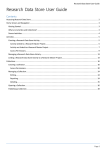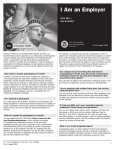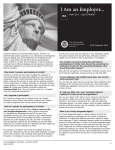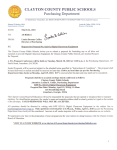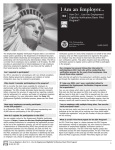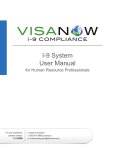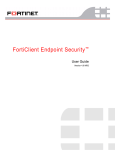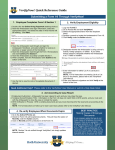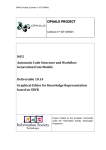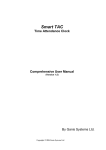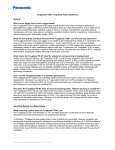Download NC STATE UNIVERSITY and - CUPA-HR
Transcript
NC STATE UNIVERSITY and bring you E-Verify – Tips From NC State University Or “Been There, Done That, Got the E-Verify T-Shirt” Jill M. Guzman, Manager, International Employment Kathy P. Lambert, Director, HR Employment Services Barbara L. Carroll, Associate Vice Chancellor for HR North Carolina State University =================================================================== BREAKING NEWS: On June 6, 2008, President Bush amended Executive Order 12989 to require that all federal contractors, including colleges and universities, begin using an electronic verification system designated by the Department of Homeland Security (DHS) to verify the employment eligibility of their workforces. On June 13, the Secretary of Homeland Security, Michael Chertoff, designated the E-Verify (formerly Basic Pilot) system to be “the” electronic employment eligibility verification system used, effective immediately. However, the Executive Order was quickly followed by a proposed rule which requires public comments be submitted by August 11, 2008. As we understand it, only after DHS reviews the public comments and publishes a final rule will any of these requirements go into effect. =================================================================== You may have already heard rumors about the quality and completeness of information in the E-Verify database. You’re trying to assess the new administrative burden that such an “unfunded mandate” will impose on your organization. NC State University has “been there” – so we know how you feel. And “done that” – so hopefully we can offer helpful insight to ease your transition to use of the system. On January 1, 2007, the State of North Carolina mandated that all state agencies, including its public universities and community colleges, use the E-Verify system. NC State University is a large research-intensive university with almost 32,000 students, more than 8,000 faculty and staff, and a high volume of temporary employees. We employ many foreign national employees, particularly in our faculty and post-doc ranks. With 18 months of experience now under our belts, we offer a general explanation of the system, a description of our implementation process, and some tips and recommendations to consider as you determine how to best implement E-Verify on your campus. We’ve also included a “Q & A” discussion on the most universal questions related to this process. The bad news is that, yes, it is a new administrative burden. The good news is that it hasn’t been quite as awful as we first feared. At NC State, we haven’t experienced the “30% non-confirmation rate” that was floating in the rumor mill. It’s been more like a 5% initial non-confirmation rate – mostly due to our high foreign national employee population – and we’ve been able to resolve every one of them. Institutions with very few foreign nationals on their payrolls should have an even better confirmation success rate. So here’s the story. The E-Verify System E-Verify is a free, Internet-based system operated by the US Citizenship and Immigration Service (USCIS), which is a part of DHS. E-Verify electronically compares information contained on the Form I-9 with records contained in the Social Security Administration (SSA) and DHS databases to help employers verify the identity and employment eligibility of newly hired employees. • The E-Verify system is not to be used to verify information for employees already hired. • The E-Verify system does not replace the requirement of employers to complete an I-9 form for all new employees within three days of hire. The E-Verify system requires that (a) the I-9 form be completed first, and retained according to specific retention rules, and (b) the information from the I-9 form be entered into the E-Verify system to confirm the person’s identity and employment eligibility. Getting Set Up on E-Verify as an Employer Employers can register online to gain access to E-Verify, by going to https://www.vis-dhs.com/EmployerRegistration. The website contains instructions on how to complete the registration process, which includes signing a Memorandum of Understanding (MOU) that provides the terms of agreement between you as the employer, the SSA, and the DHS. An administrator who has signature authority for your organization signs the MOU. An employer may choose to either (a) designate one site (such as your whole organization) to perform the E-Verify queries on behalf of the entire institution, thus needing only one MOU), or (b) it may choose to enroll multiple sites in E-Verify and have each site perform its own verification queries – each site would then be required to sign its own MOU with SSA and DHS. At NC State, we have only one MOU, but we have many users in departments (including off-campus locations) who complete I-9s and access E-Verify. Program Administrators and General Users of the E-Verify System Once an employer has registered and signed the MOU, all individuals who will be performing queries must complete a free, online tutorial on the E-Verify website. They should also review the User Manual and MOU, which are also available on the website. The tutorial explains the E-Verify process in great detail, and provides step-by-step examples of how to successfully enter a query. Once a user has completed the online tutorial, s/he may begin entering data from I-9 forms into the system to verify employment eligibility. An employer can have an unlimited number of “General Users.” It can also designate certain people as “Program Administrators,” who can create user accounts for new General Users, as well as view reports, perform queries, update profile information, and unlock user accounts. At NC State, we designated key personnel contacts in each of our colleges and major divisions as Program Administrators to facilitate proper access and user updates. At NC State, we have very decentralized hiring processes, where departments do much of the hiring set-ups and verifications themselves. If you do all your I-9s centrally, you can really limit the numbers of Program Administrators and General Users. • The employer must initiate an E-Verify query no later than the end of three business days after the new hire’s actual start date, and after the I-9 form has been completed by both the employee and employer. • However, the E-Verify system also requires that the new hire have a valid Social Security Number (SSN). • If the new employee does not yet have a SSN, the employer should wait to run the E-Verify query until that employee has received a SSN. The I-9 form itself must still be completed within three days of hire, and a notation should be made to explain why the E-Verify query was not run within three days of hire. Currently the E-Verify system does not allow for a direct upload of information from institutions using an electronic I-9 system, so information from electronic I-9 forms either need to be manually entered by a General User, or the electronic I-9 service vendor will need to work with USCIS to develop an interface between the commercial I-9 system and the E-Verify database. NC State’s Implementation Experience In 2007, NC State only had a few weeks to figure out how the process worked and how we would disseminate information and training to the people that needed it. On our campus, the I-9 employment verification process is decentralized. Each of our units, departments and colleges is responsible for handling the I-9 process for their new employees [although the International Employment (IE) group within Human Resources has ultimate responsibility for ensuring compliance with these requirements]. Because of this structure, we determined that the E-Verify process should similarly be decentralized and that the individuals across campus who were responsible for handling the I-9 process would also be responsible for entering queries into the E-Verify system. Training for Users Our next challenge was to determine how to best and most efficiently provide information and training to those people who were (unbeknownst to them) getting ready to gain this new responsibility. After we registered the University on the E-Verify website and signed the MOU, three IE staff took the tutorial and gained access to the system as Program Administrators. Next, we identified key personnel contacts in each college and division and sent them an email explaining the new E-Verify requirement, and provided Program Administrator user names and accounts for them. We held mandatory training sessions to walk them through the online tutorial and answer questions before they began to create General User accounts for the people within their own units who would need access. Not surprisingly, there was a bit of initial panic across campus about the new responsibility but this quickly settled down once the General Users realized that the online tutorial provided the needed training and that the information they needed to input into the system could be taken directly from the I-9 form, in most cases. In order to continue to support the General Users (and the Program Administrators) across campus, we also offer periodic training on I-9 and E-Verify systems, not only to refresh and update information as necessary for our “long time” users of the system, but also to provide training to new people who become responsible for these processes. In our experience, since we provided continual and easily accessible information, the General Users got over initial resistance and adapted to the new requirement fairly quickly. Confirmations and Non-Confirmations In the vast majority of cases, the E-Verify system returns a virtually instantaneous result of “Employment Verified.” NC State’s IE Office provided information to campus users on what to do if the system returned a result of “SSA tentative non-confirmation” or “DHS verification in process” or “DHS tentative non-confirmation.” Much to the relief of our General Users, we chose to handle all non-confirmations centrally in IE. We deal individually with the affected employee, so General Users do not have to know how to handle the various situations that can cause a non-confirmation. “SSA tentative non-confirmations” affect both U.S. citizens/permanent residents as well as foreign nationals. This is typically because of typos or misinformation keyed into the system at some point in the SSN process. “SSA non-confirmations” can involve the new employee directly calling or visiting a local SSA office individually. Foreign Nationals The biggest challenge we have faced is the higher percentage of issues with foreign national employees, especially foreign national students who will be on our payroll. “DHS verifications in progress” and “DHS tentative non-confirmations” impact foreign national employees almost exclusively. NC State experiences hundreds of non-confirmations at the start of each semester when foreign students are beginning on-campus assistantships or other employment. We have been able to successfully resolve every DHS tentative non-confirmation, however the process involves someone in IE sitting with each employee to call the DHS 1-888 number about his/her particular situation, so it takes a fair amount of time and effort. The work is also time-sensitive, since E-Verify rules require that a tentative nonconfirmation be resolved within eight (8) federal government workdays. However, if the issue is not resolved within the allotted 8 days, DHS can put a case into “continuance;” if it does so, it instructs the employer to take no action against the employee (i.e. not to terminate the person) until the matter is resolved. Interactions Between E-Verify and the SEVIS System In addition, with regard to foreign student employees, departments sometimes process a foreign student’s employment paperwork before the federal SEVIS system has been updated to reflect that the student has officially checked in at NC State to begin studies. HR departments may not be familiar with SEVIS, but your student admissions people who deal with international students will be. If the SEVIS system is not properly updated, then the E-Verify system, which extracts some of its information from SEVIS, will automatically return a “DHS verification in progress” response. This will change to a “DHS tentative non-confirmation” response within 24 hours. The only way to resolve this issue is for the foreign student to immediately check in with the appropriate campus office so that SEVIS can be updated and then to come to us so we can contact DHS directly to get the “employment authorized” result that we need. Is the E-Verify System Beneficial? The federal government asserts that E-Verify promotes the integrity of the employment verification process of the U.S. workforce, and is a valuable tool in assuring employer compliance with employment laws and regulations. Because NC State also conducts comprehensive, mandatory background checks for all new hires, potential applicants probably never even apply if they are not in legal status and do not have work authorization. So, in NC State’s case, the E-Verify system has so far not “caught” anyone who was not been eligible to work, and we haven’t had to terminate anyone based on the results of the E-Verify screening process. The good news is that E-Verify is a double-check that our hiring practices are working. The bad news is that it is a material amount of effort for not much added result. If your campus doesn’t have mandatory background check process, the E-Verify System might produce different results. Tips and Recommendations Whether the I-9 process at your institution is centralized or decentralized, there are several basic steps that we recommend you consider taking when implementing the E-Verify system: 1. Identify who will “own” the E-Verify implementation, rollout, and ongoing management for your campus. At NC State, the E-Verify process “Owner” is the IE group within HR. 2. Determine whether you will have a centralized or decentralized process – a centralized process will involve a lot less training and information dissemination. A decentralized process spreads the workload around, which can be helpful during peak hiring periods. 3. Determine who will review and sign the MOU for your institution (and/or whether you might need several MOUs due to multiple hiring sites/locations). 4. Have the Owner(s) go through the online E-Verify tutorial and get themselves set up as Program Administrators, so that they can oversee the process and add other Program Administrators and/or General Users as necessary. 5. Identify who else (if anyone) will be a Program Administrator. Because of NC State’s size, we didn’t want to only our IE group designated this way, so we identified additional key people within each college and division to share this designation. 6. Identify who the General Users will be and have the Program Administrator(s) set up their accounts and passwords. 7. Provide training, or at least detailed information, to the Program Administrators and General Users about the E-Verify system in general and how to get started. 8. Determine how you will handle situations where the system returns a “SSA tentative non-confirmation,” “DHS verification in process,” or “DHS tentative nonconfirmation.” Although the online tutorial provides clear information on what the next steps need to be, you will need to determine who is responsible for communicating this information to the new employee and who will assist the foreign national employee in speaking with a DHS official to get the situation resolved. 9. Provide periodic training for new and experienced users of the system, especially since DHS and SSA provide informational updates and news items on the E-Verify website, some of which further clarify or explain or revise what data to input into the system. 10. Work closely with your campus office for International Students (or wherever your SEVIS experts are housed), because of foreign student employment issues, especially at the start of each new semester. FAQs 1. How does an organization register for participation in E-Verify? You can register for E-Verify at https://www.vis-dhs.com/EmployerRegistration, which provides instructions for completing the registration process. At the end of the registration process, you will be required to sign a Memorandum of Understanding (MOU) that provides the terms of agreement between you the employer, the SSA, and USCIS. An employee who has signatory authority for the employer can sign the MOU. 2. How should multiple hiring sites register? Each site that will perform the employment verifications must go through the registration process and sign an individual MOU. 3. Can one site verify all new hires across all sites on campus? Yes, one site may verify new hires at all sites. When registering, the individual at that site should select “multiple site registration” and give the number of sites per state it will be verifying. 4. After an employer registers, how does E-Verify work? Using an automated system, the process involves verification checks of SSA and DHS databases. The E-Verify MOU, User Manual, and Tutorial contain instructions and other information on procedures and requirements. Once the user has completed the tutorial, s/he may immediately begin using the system 5. When does an employer initiate an E-Verify query? The earliest an employer may initiate a query is after the employee accepts employment and after the I-9 form has been completed. The employer must initiate the query no later than the end of three (3) business days after the actual start date. The employer may not pre-screen applicants using E-Verify, and may not re-verify employees who have temporary work authorization. 6. What information is required to conduct a verification of a new employee? The employer must submit a query that includes information from Sections 1 and 2 of the I-9 form, including: employee’s name and date of birth; social security number; citizenship status attested to; an A number or I-94 number if applicable; type of document(s) provided on the I-9 form to establish work authorization; and proof of identity and its expiration date, if applicable. The E-Verify system will respond to the initial query within seconds. Please note that the identification documents presented for I-9 purposes must contain a photograph. 7. Which employees should be verified through the E-Verify system? Employers are required to verify all new hires, both U.S. citizens and non-citizens. Employers may not verify selectively and must verify all new hires while participating in the program. This includes all students and temps on your payroll, not just full time faculty and staff. 8. Does E-Verify certify the immigration status of a new hire who is not a U.S. citizen? No; E-Verify only confirms a new hire’s employment eligibility, not his or her immigration status. 9. What should you do if your new employee does not have a Social Security Number (SSN)? The E-Verify system requires that the new employee have a valid SSN, and there are no exceptions. If your employee does not yet have an SSN, you should complete the I-9 process as required and then wait until s/he obtains a SSN before running the E-Verify query. You should note on the I-9 form why you have not yet run the E-Verify query, and your employee should be instructed to provide you with the new SSN as soon as possible. In the meantime, because you will have completed the I-9 process with that new employee to verify work authorization, your employee is allowed to work temporarily without the SSN or the E-Verify system result. 10. Does participation in E-Verify provide a “safe harbor” from worksite immigration enforcement actions? No; however, an employer who verifies work authorization using E-Verify is presumed to not have knowingly hired an unauthorized worker. 11. What documentation do you need to keep to indicate that you initiated a query in E-Verify for a new hire? If employment is authorized by the E-Verify system, you should either make a notation of the E-Verify Case Verification Number on the I-9 form, or print out and attach the case details sheet to the I-9 form. If employment is not immediately authorized, you should inform the new employee about the non-confirmation and explain the next steps to be taken to resolve the situation. 12. Does E-Verify require that you make copies of documents presented for I-9 purposes? The E-Verify system requires employers to make and attach copies of Permanent Resident Cards and Employment Authorization Cards but only if they are presented by the new employee as their freely chosen documents for completion of Section 2 of the I-9 form. E-Verify does not require that copies of any other documents be made or kept. 13. Once you receive the “employment authorized” message in E-Verify, how do you actually exit the query? The General User should click on the “Resolve Case” button, and then the “Close” button. The case remains pending in the system until it is officially resolved and closed. Once employment is authorized, no further action is required, so the case can be resolved and closed. 14. What do you do when the employee’s case receives a “SSA tentative non-confirmation” result? When an employee’s case receives a “SSA tentative non-confirmation” result, print out the tentative non-confirmation notice and provide it to the employee. The employee will check on the notice that s/he will either “contest” or “not contest” the non-confirmation and then should sign the notice. If the employee chooses to “not contest” the nonconfirmation, then it automatically becomes a final non-confirmation and you must terminate that employee. If the employee chooses to “contest” the tentative non-confirmation, the General User should click on the “initiate SSA referral” button to print out the Social Security Administration referral letter for the employee to sign. The employee should take that letter to the nearest Social Security Administration office within eight (8) federal government workdays and someone from the SSA will sign the referral letter and resolve the case in the E-Verify system. The employer needs to see electronic or written confirmation that the discrepancy has been resolved and that employment is now authorized in the system. 15. What do you do when the employee’s case receives a “DHS tentative non-confirmation” result in the system? When an employee receives a “DHS tentative non-confirmation” result, the General User should print out the tentative non-confirmation notice and provide it to the employee. The employee should check that s/he will “contest” the non-confirmation and sign the form. The employee should be given the DHS referral letter (which is printed out from the system) and informed to contact, within eight (8) federal government workdays, either the appropriate Program Administrator for additional assistance in resolving the issue with DHS or DHS directly to resolve his/her case. 16. If a foreign national – or a nationalized U.S. citizen – has a one-word legal name (so, not a “first” name + “last” name), how do you enter it into the E-Verify system? When the employee only has one legal name, enter “unknown” into the “first name” block, and the one legal name into the “last name” block. If the employee only has one initial for a first name, enter a period after the initial in the “first name” block. 17. Has the SSA or DHS ever modified, evaluated or improved the E-Verify system? According to the federal government, the E-Verify tutorial and training program are being reformulated to address issues such as H-1B portability, automatic extensions of work authorizations for certain non-immigrants, refugees with unlimited right to work, etc. Although the data entry requirements of E-Verify will not change, additional employer training and FAQs will be developed and offered through the website. 18. How can I find out more information about E-Verify? To find out more information about the E-Verify system, visit www.dhs.gov/e-verify or call the dedicated E-Verify Customer Service number at 1-888-464-4218. If We Can Help… For information regarding NC State’s experience, please contact [email protected] or [email protected].










